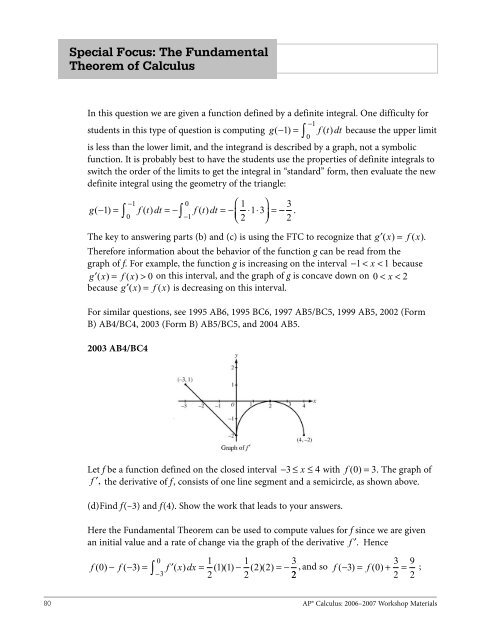AP Calculus
Calculus_SF_Theorem
Calculus_SF_Theorem
You also want an ePaper? Increase the reach of your titles
YUMPU automatically turns print PDFs into web optimized ePapers that Google loves.
Special Focus: The Fundamental<br />
Theorem of <strong>Calculus</strong><br />
In this question we are given a function defined by a definite integral. One difficulty for<br />
students in this type of question is computing g( − ) = − 1<br />
1 f ( t)<br />
dt because the upper limit<br />
is less than the lower limit, and the integrand is described by a graph, not a symbolic<br />
function. It is probably best to have the students use the properties of definite integrals to<br />
switch the order of the limits to get the integral in “standard” form, then evaluate the new<br />
definite integral using the geometry of the triangle:<br />
−1<br />
0 ⎛ 1 ⎞<br />
g( − 1) = ∫ f ( t) dt = − ∫ f ( t)<br />
dt = − ⋅ ⋅<br />
⎝<br />
⎜<br />
⎠<br />
⎟ =<br />
−<br />
2 1 3 − 3 0<br />
1<br />
2 .<br />
The key to answering parts (b) and (c) is using the FTC to recognize that g′ ( x) = f ( x).<br />
Therefore information about the behavior of the function g can be read from the<br />
graph of f. For example, the function g is increasing on the interval − 1 < x < 1 because<br />
g′ ( x) = f ( x) > 0 on this interval, and the graph of g is concave down on 0 < x < 2<br />
because g′ ( x) = f ( x) is decreasing on this interval.<br />
For similar questions, see 1995 AB6, 1995 BC6, 1997 AB5/BC5, 1999 AB5, 2002 (Form<br />
B) AB4/BC4, 2003 (Form B) AB5/BC5, and 2004 AB5.<br />
2003 AB4/BC4<br />
∫<br />
0<br />
Let f be a function defined on the closed interval −3 ≤ x ≤ 4 with f ( 0) = 3.<br />
The graph of<br />
f ′, the derivative of f, consists of one line segment and a semicircle, as shown above.<br />
(d) Find f(–3) and f(4). Show the work that leads to your answers.<br />
Here the Fundamental Theorem can be used to compute values for f since we are given<br />
an initial value and a rate of change via the graph of the derivative f ′. Hence<br />
0 1<br />
f ( 0) f ( 3) f ( x) dx ( )( ) ( )( )<br />
2 1 1 1<br />
2 2 2 3<br />
− − = ∫ ′ = − = − , and so f f<br />
−3<br />
2 ( − 3) = ( 0)<br />
+ 3<br />
2<br />
=<br />
9<br />
2 ;<br />
80<br />
<strong>AP</strong>® <strong>Calculus</strong>: 2006–2007 Workshop Materials


